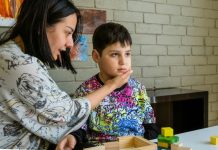
Autism spectrum disorders affect one in 59 American children by age eight.
With no known quantitative biological features, autism diagnoses are currently based on expert assessments of behavioral symptoms, including impaired social skills and communication, repetitive behaviors and restricted interests.
Scientists typically aim for potential treatments at specific pathologies in brain diseases, such as the tangles and plaques that characterize Alzheimer’s disease and the Lewy bodies seen in Parkinson’s.
Until now, they have not had a promising target like that in autism.
In a recent study from Beth Israel Deaconess Medical Center, researchers found cellular features consistent with an immune response targeting specialized brain cells in more than two-thirds of autistic brains.
These cellular characteristics—not previously observed in autism—lend critical new insight into autism’s origins and could pave the way to improved diagnosis and treatment for people with this disorder.
The study is published in the Annals of Neurology. The lead author is Matthew P. Anderson, MD, Ph.D., a physician-scientist.
In the study, the team examines brains donated to Autism BrainNet, a non-profit tissue bank when they noticed the presence of perivascular lymphocyte cuffs—an accumulation of immune cells surrounding blood vessels in the brain.
They also found mysterious bubbles or blisters that scientists call blebs accumulating around these cuffed blood vessels.
They subsequently showed these blebs contained debris from a subset of brain cells called astrocytes.
Not previously linked to autism, perivascular lymphocyte cuffing is a well-known indicator of chronic inflammation in the brain.
Lymphocyte cuffs in the brain are telltale signs of viral infections or autoimmune disorders.
But the pattern the team observed did not match any previously documented infection or autoimmune disorder of the brain.
To find out if the perivascular lymphocyte cuffs in this sample of autistic brains were linked to autism spectrum disorder, the team compared 25 brains from donors diagnosed with the disorder to 30 brains from neurotypical brain donors.
These neurotypical control cases were selected to approximate the age range and medical histories of the autism group.
Present in more than two-thirds of the autistic brains, perivascular lymphocyte cuffing significantly surpassed that in the control cases.
The team found that the perivascular cuffs were made up of killer T-cells, a subset of immune cells responsible for attacking and killing damaged, infected or cancerous cells or normal cells in autoimmune diseases.
With no apparent evidence of viruses known to infect the brain, the presence of these tissue-attacking immune cells throughout the autistic brains suggested one of two scenarios.
Either the T-cells are reacting normally to a pathogen such as a virus, or they are reacting abnormally to normal tissue—the definition of an autoimmune disorder.
The team says the findings support the idea that autism may be an autoimmune disorder, just like multiple sclerosis is thought to be.
Copyright © 2019 Knowridge Science Report. All rights reserved.



